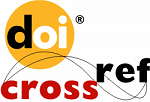Development of Cooperative Learning Think-Talk-Write (TTW) Models Based on Batak Culture to Improve Students’ Mathematical Critical Thinking Ability
Abstract
This study aimed to develop valid, practical, and effective Think-Talk-Write (TTW) learning tools based on Batak culture. Plomp's research design was used in this study. This development research product was a valid, practical, and effective TTW learning tools based on Batak culture, which can improve students' mathematical critical thinking ability. The results of the study are (1) TTW learning model based on Batak culture belonged to the valid category; (2) the practicality of the TTW learning tools based on Batak culture belonged to the high category; and (3) the effectiveness of the TTW learning tools based on Batak culture based on (a) classical student learning completeness was 88.89%; (b) the use of learning time criteria was in the high category; (c) the teacher's ability to manage learning criteria was in the high category, and (d) many students gave positive responses to the components and learning activities.
Keywords
Full Text:
PDFReferences
Aizikovitsh-Udi, E., & Cheng, D. (2015). Developing critical thinking skills from dispositions to abilities: mathematics education from early childhood to high school. Creative Education, 6(04), 455.
Angriani, A. D., Bernard, Nur, R., & Nurjawahirah. (2016). Meningkatkan Kemampuan Pemecahan Masalah Melalui Pembelajaran Kooperatif Think Talk Write Pada Peserta Didik Kelas VIII MTsN Model Makassar. MaPan: Jurnal Matematika Dan Pembelajaran, 4(1), 11–28.
Arends, R. I. (2008). Sistem Pembelajaran. Pustaka Pelajar.
Bandura, A. (1997). Self-efficacy: The exercise of control. W.H. Freeman.
Bustami, Y., Riyati, Y., & Education, B. (2019). Biosfer : Jurnal Pendidikan Biologi impact of critical thinking skills. 12(1), 13–23.
Darr, C., & Fisher, J. (2004). elf-Regulated Learning in Mathematics Class. www.arb.nzcer.org.n-z
De Corte, E. (1996). Changing views of computer supported learning environments for the acquisition of knowledge and thinking skills. International Perspectives on the Design of Technology-Supported Learning Environments, 129–145.
Depdiknas. (2006). kurikulum Tingkat Satuan Pendidikan. Depdiknas.
Dewimarni, S. (2017). Kemampuan Komunikasi Dan Pemahaman Konsep Aljabar Linier Mahasiswa Universitas Putra Indonesia ‘YPTK’ Padang. Al-Jabar: Jurnal Pendidikan Matematika, 8(1), 53–62.
Fitri, S., Syahputra, E., & Hermawan, S. (2019). Blended Learning Rotation Model Of Cognitive Conflict Strategy To Improve Mathematical Resilience In High School Students. International Journal Of Scientific & Technology Research, 8(12).
Fuad, N. M., Zubaidah, S., Mahanal, S., & Suarsini, E. (2017). Improving junior high schools’ critical thinking skills based on test three different models of learning. International Journal of Instruction, 10(1), 101–116. https://doi.org/10.12973/iji.2017.1017a
Graciella, M., & Suwangsih, E. (2016). Penerapan Pendekatan Matematika Realistik Untuk Meningkatkan Kemampuan Representasi Matematis Siswa. Metodik Didaktik: Jurnal Pendidikan Ke-SD-An, 10(2), 27–36.
Lanvin, B., & Evans, P. (2016). The global talent competitiveness index (Talent and). INSEAD Fontainebleau.
Morin, L. L., Watson, S. M. R., Hester, P., & Raver, S. (2017). The Use of a Bar Model Drawing to Teach Word Problem Solving to Students With Mathematics Difficulties. Learning Disability Quarterly, 40(2), 91–104.
OECD. (2016). Programe for International Student Assesment (PISA) Result form PISA 2015. OECD Publishing.
Plomp, T. (n.d.). Educational and Training System Design. University of Twente Faculty of Educational Science and Technology.
Posamentier, A. S., & Stepelmen, J. (1990). Teaching Secondary School mathematics: Techniques and Enricment Units (3 Ed.). Merrill Publishing Company.
Prastini, & Retnowati. (2014). Peningkatan Keterampilan Sosial dan Hasil Belajar IPS melalui Kooperatif TGT di SMPN 1 Secang. Jurnal Harmoni Sosial, 1(2), 165–178.
Saragih, S., & Napitupulu, E. (2015). Developing student-centered learning model to improve high order mathematical thinking ability. International Education Studies, 8(6), 104–112. https://doi.org/10.5539/ies.v8n6p104
Sinaga, B. (2007). Pengembangan Model pembelajaran matematika Berdasarkan Masalah Berbasis Budaya Batak (PBMB3). PPs Universitas Negeri Surabaya.
Sister, D., Syahputra, E., & Sinaga, B. (2020). Analysis of Students‟ Difficulties In Mathematical Creative Thinking On Problem-Based Learning Model. International Journal Of Scientific & Technology Research, 9(3).
Susanto, A. S., Bharata, H., & Dahlan, S. (2018). The effect of Cooperative Learning Model Think-Talk-Write Type on Mathematical Problem-Solving Abilities In Terms of Learning Habits. Al-Jabar: Jurnal Pendidikan Matematika, 9(1), 33–40.
Syahputra, E., & Utami, D. R. (2019). The design of IQF-oriented ARCS-based learning model. Journal of Physics: Conference Series, 1315(1). https://doi.org/10.1088/1742-6596/1315/1/012065
Widyatiningtyas, R., Kusumah, Y. S., Sumarmo, U., & Sabandar, J. (2015). The impact of problem-based learning approach tosenior high school students’ mathematics critical thinking ability. Journal on Mathematics Education, 6(2), 30–38. https://doi.org/10.22342/jme.6.2.2165.107-116
Wijaya, A. (2012). Pendidikan Matematika Realistik: Suatu Alternatif Pendekatan Pembelajaran Matematika. Graha Ilmu.
Yuliani, K., & Suragih, S. (2015). The Development Of Learning Devices Based Guided Discovery Model To Improve Understanding Concept And Critical Thinking Mathematically Ability Of Students At Islamic Junior High School Of Medan. Journal of Education and Practice, 6(24), 116–128. http://search.proquest.com/docview/1773215035?accountid=8330
DOI: http://dx.doi.org/10.24042/ajpm.v11i2.7289
Refbacks
- There are currently no refbacks.

Al-Jabar : Jurnal Pendidikan Matematika is licensed under a Creative Commons Attribution-ShareAlike 4.0 International License.






